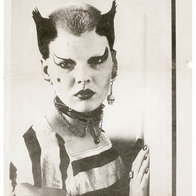Punk
dal 14/5/2008 al 6/9/2008
Segnalato da
Leigh Bowery
Derek Jarman
Linder
Malcolm McLaren
Genesis P'Orridge
Jamie Reid
Johnny Rozsa
Jon Savage
Vivienne Westwood
Stephen Willats
Cerith Wyn Evans
Bill Woodrow
Vito Acconci
Lynda Benglis
Richard Hambleton
Richard Kern
Robert Longo
Ann Magnuson
Robert Mapplethorpe
Mark Morrisroe
Tony Oursler
Christy Rupp
Alan Vega
Arturo Vega
David Wojnarowicz
Elvira Bach
Jorg Buttgereit
Einsturzende Neubauten
Luciano Castelli
endart
Die todliche Doris
Manfred Jelinski
Walter Gramming
Hormel & Buhler
Malaria!/Mania D
Martin Kippenberger
Maye & Rendschmidt
Notorische Reflexe
Salome'
Wolkenstein & Markgraf
Yana Yo
Thomas Miessgang
14/5/2008
Punk
Kunsthalle Wien, Wien
No One is Innocent. Looking back from a distance of thirty years, the exhibition, focusing on the three metropolises New York, London, and Berlin as examples, reveals how differently and yet consistently Punk as a metaphor of revolt influenced music, fine art, and the look of young people in various cultural spheres. While it was mainly a style and fashion phenomenon in England, a close association between artists and Punk musicians was characteristic of the scene in the USA and Germany. Curator: Thomas Miessgang.

Curator: Thomas Mießgang
Besides Hip Hop, Punk was the last global pop-cultural movement that aimed to be more than just an acoustic
furnishing of teenager bedrooms: a complete upheaval in fashion, gestures of style, artistic forms of expression,
and music from the improve the world poses rampant in the sixties’ Summer of Love to the nihilism and no
future slogans of the Winter of Hate ten years after; from the soft and shapeless psychedelic color games to the
sharp contrasts and angular designs of the neon and plastic era. Punk was about an attitude of protest fuelled
by the spirit of the Situationist International, an extreme left-wing group of European artists and intellectuals who
lived for “carrying gasoline to where there was fire” (Guy Debord).
The exhibition Punk. No One is Innocent, which focuses on the three metropolises New York, London,
and Berlin as examples, reveals how differently and yet consistently Punk influenced the fine arts, young
people’s looks, and the ciphers of revolt in different cultural spaces and socio-political milieus. While it was
mainly a style and fashion phenomenon in England, where it brought forth a typical graphic art, a close
association between artists and punk rockers characterized the scene in the USA and Germany from the very
beginning many of the artists and avant-garde filmmakers like Jim Jarmusch, Wolfgang Müller, Alan Vega,
and Salomé also played in bands.
Pop theorist Greil Marcus remarked about the Sex Pistols’ song “Anarchy on the UK,” which all of a
sudden made the phenomenon of Punk hit the front pages throughout the world: “It is just a pop song, a
would be, has been hit record, a cheap commodity. […] It is a joke and yet the voice that carries it remains
something new in rock ’n’ roll, which is to say something new in postwar popular culture: a voice that denied all
social facts, and in that denial affirmed that everything was possible. It remains new because rock ’n’ roll has
not caught up with it.”
The vanguard of the British Punk movement comprised the manager and anarchist intellectual
Malcolm McLaren, the fashion designer Vivienne Westwood, and the graphic artist Jamie Reid. Together, they
created a visual corporate identity of Punk which several generations would draw on: a safety pin in Queen
Elizabeth’s cheek, t-shirts with shock motifs, S/M fashion for the subversive flâneur, typographical solutions
featuring letters cut from newspapers that imitated blackmail notes. The idea of punk was an assault on the
masses’ consciousness. The public was symbolically taken hostage and bombarded with demands,
impositions, and optical shocks.
Though the British semiotics guerilla may have originally intended to distil “cash from chaos,” things
soon took a different turn: Punk turned into a turmoil of signs and emblems, a cacophony of ideologically
KUNSTHALLE wien, Punk. No One is Innocent, 3rd press release, April 2008
molded meanings transformed into an annihilation of meaning with destructive furor. From today’s perspective,
it is less the (after all) rather one-sided musical dimension of Punk that has brought to bear a sustainable
impact, but the play with iconographies and art-immanent relationships, the mentality of unswerving negation
opening up spaces of the possible. Punk made you feel how it was to have been lost to the world and to
pursue the genesis of a new individuality in subjective dreams at the same time.
The exhibition Punk. No One is Innocent in the Kunsthalle Wien shows that Punk was a radical
aesthetical statement which mainly showed itself in a revolution of signs and triggered productive irritation with
its DIY approach. The optical traces of this movement, which has become part of history for quite some time
now, have informed artistic modes of expression to this day and long since entered the gallery and fashion
mainstream through protagonists such as Laurie Anderson und Vivienne Westwood.
Apart from works of art, the exhibition includes historical artifacts such as flyers, record sleeves,
manifestos, and photographic documentations, as well as typical style emblems which still become manifest as
the genetic code of a pop-culturally encoded White Riot today.
Participating artists
LONDON: Leigh Bowery, Derek Jarman, Linder, Malcolm McLaren, Genesis P-Orridge, Jamie Reid, Johnny Rozsa, Jon Savage, Vivienne Westwood, Stephen Willats, Cerith Wyn Evans, Bill Woodrow
NEW YORK: Vito Acconci, Lynda Benglis, Richard Hambleton, Richard Kern, Robert Longo, Ann Magnuson, Robert Mapplethorpe, Mark Morrisroe, Tony Oursler, Christy Rupp, Alan Vega, Arturo Vega, David Wojnarowicz
BERLIN: Elvira Bach, Jörg Buttgereit, Einstürzende Neubauten, Luciano Castelli, endart, Die tödliche Doris, Manfred Jelinski, Walter Gramming, Hormel & Bühler, Malaria!/Mania D, Martin Kippenberger, Maye & Rendschmidt, Notorische Reflexe, Salomé, Wolkenstein & Markgraf, Yana Yo
Catalogue: A catalogue with texts by Thomas Mießgang, Wolfgang Müller, Glenn O’Brien, and Jon Savage will
be published to accompany the exhibition.
Press preview: Thursday, 15 May 2008, 10 a.m.
Opening: Thursday, 15 May 2008, 7 p.m.
Kunsthalle Wien
Museumsplatz 1 - Wien



